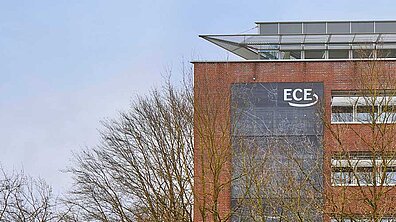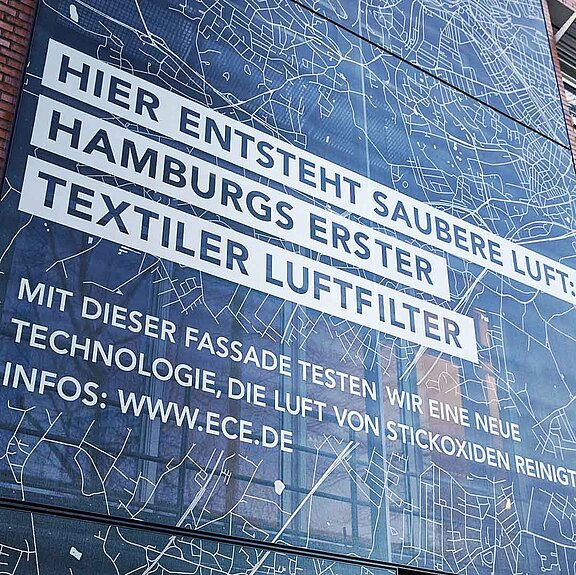Sustainable façade for better air
The air in German cities is often worse than the EU limits allow. Particulate matter and nitrogen oxides impair the quality of the air and their prevention is an effective lever for climate protection. Particulate matter pollution has a major impact on the development of cardiovascular and respiratory diseases as well as the general mortality rate of the population. We are the market leader for tailor-made real estate concepts and a pioneer in sustainable solutions in the development sector. Under the scientific supervision of RWTH Aachen University, we have tested the world's first textile façade that filters harmful nitrogen oxides from the air on an office building at our company campus in Hamburg.
55%
reduction of nitrogen oxides under laboratory conditions
78%
reduction of solar cooling loads of houses
100%
recyclebar
1/3
reduction of pollution

Successful test run
From February 2020 to December 2021, the 16.5-metre-high and 4.8-metre-wide textiles were tested on the outer wall of an ECE office building directly on the busy Saseler Damm (Ring 3): the innovative textile air filter reduced pollutant levels by a third. According to RWTH, there were even 55 percent fewer nitrogen oxides in the air under laboratory conditions. The air filter binds harmful nitrogen oxides (NO and NO2) produced by car exhaust fumes. In addition, the textile surface also serves as external sun protection. Studies have shown that the innovative building envelope can reduce the solar cooling loads of houses by up to 78 percent - and thus reduce their CO2 emissions.
100 percent recyclable
In addition to the proven filter performance and the reduction in CO2 emissions, the new textile façade is characterized by other sustainable aspects: For example, the textile cladding can be used to easily embellish building facades. After the use phase on the building, the textile fabric can also be 100% recycled. Incidentally, the textile cladding has no adverse effect on the people inside the building: the special structure of the textiles means they have a clear view of the outside.
Anti-smog coating as a miracle cure
The secret of the textile façade: it is coated with a photocatalytic anti-smog coating that breaks down harmful air pollutants. The miracle product with which the textile façade is coated is called nanotitanium dioxide. It is made from the natural metal titanium dioxide, which, when exposed to light and humidity, converts harmful nitrogen oxides into harmless nitrate, which is simply washed out with the next rainfall and enters the soil as fertilizer. As part of an environmental impact assessment, RWTH Aachen University took a close look at the rainwater. The result: the nitrate concentrations of the samples taken from the façade were completely harmless - the rainwater complied with the EU nitrate limits for drinking water.
Follow-up project with the "Lebendige Stadt" foundations
In view of ever stricter laws on air pollution control, there is also an urgent need for action for many local authorities. ECE is therefore working with the "Lebendige Stadt" foundation, which it initiated, to find solutions to further reduce air pollution in urban areas. Following the successful research project at the ECE corporate campus, a follow-up project of the "Lebendige Stadt" foundation will now focus on investigating the external effect of such a textiles façade in urban areas in more detail.

"Acting sustainably is a central corporate objective of ECE. This also includes being open to new technologies. We are therefore delighted to be testing Germany's first nitrogen oxide-binding textile façade at our corporate campus and to be able to provide new insights for other sites with this pilot project. This would be an important contribution to climate protection that starts on our own doorstep."
Andreas Mattner

"We have developed the air-purifying textile façade specifically for environmental and health protection. At the same time, we combine energy efficiency with an innovative design in the façade. We have also decided to take a sample of rainwater from the façade in order to test and scientifically prove its environmental compatibility."
Jan Serode, RWTH Aachen

